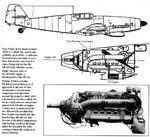- Thread starter
- #61
davebender
1st Lieutenant
If Germany had chosen to mass produce the DB603 engine early and in greater numbers then the entire issue is moot. Dr. Tank would get his wish to mass produce the Fw-190C.Changes necessary would have to remain minimal: the DB 628 or DB 603

